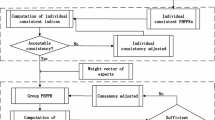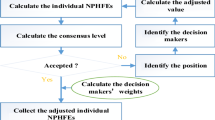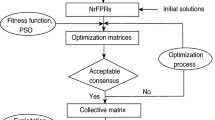Abstract
As a generalized fuzzy number, the hesitant fuzzy element (HFE) has been receiving increased attention and has recently become a popular topic. However, we find that the occurring probabilities of the possible values in the HFE are equal, which is obviously impractical. Consequently, in this paper, we propose a hesitant fuzzy number with probabilities, called the hesitant probabilistic fuzzy number, and construct its score function, deviation function, comparison laws, and its basic operations. It is well known that in the context of a group of decision makers (DMs), one of the basic approaches to built consensus is to aggregate individual evaluations or individual priorities. Thus, to use the hesitant fuzzy numbers for consensus building with a group of DMs, we further propose a method called maximizing score deviation method to obtain the DMs’ weights under the HPFE environment, based on which two extended and four new ordered weighted operators are provided to fuse the HPFE information and build the consensus of the DMs. We also analyze the differences among these ordered weighted operators and provide their application scopes. Finally, a practical case is provided to demonstrate consensus building with a group of DMs under the HPFE environment using the proposed approaches.
Similar content being viewed by others
References
Altuzarra, A., Moreno-Jiménez, J. M., & Salvador, M. (2010). Consensus building in AHP-group decision making: A Bayesian approach. Operations Research, 58, 1755–1773.
Beliakov, G., Calvo, T., & James, S. (2014). Consensus measures constructed from aggregation functions and fuzzy implications. Knowledge-Based Systems, 55, 1–8.
Brock, H. W. (1980). The problem of utility weights in group preference aggregation. Operations Research, 28, 176–187.
Cabrerizo, F. J., Chiclana, F., Al-Hmouz, R., Morfeq, A., Balamash, A. S., & Herrera-Viedma, E. (2015). Fuzzy decision making and consensus: Challenges. Journal of Intelligent and Fuzzy Systems, 29(3), 1109–1118.
Cabrerizo, F. J., Moreno, J. M., Pérez, I. J., & Herrera-Viedma, E. (2010). Analyzing consensus approaches in fuzzy group decision making: Advantages and drawbacks. Soft Computing, 14(5), 451–463.
Dong, Y. C., Chen, X., & Herrera, F. (2015). Minimizing adjusted simple terms in the consensus reaching process with hesitant linguistic assessments in group decision making. Information Sciences, 297(5), 95–117.
Dong, Y. C., Xu, Y. F., Li, H. Y., & Feng, B. (2010). The OWA-based consensus operator under linguistic representation models using position indexes. European Journal of Operational Research, 203, 455–463.
Gou, X. J., & Xu, Z. S. (2016). Exponential operations for intuitionistic fuzzy numbers and interval numbers in multi-attribute decision making. Fuzzy Optimization and Decision Making. doi:10.1007/s10700-016-9243-y.
Herrera-Viedma, E., Cabrerizo, F. J., Kacprzyk, J., et al. (2014). A review of soft consensus models in a fuzzy environment. Information Fusion, 17, 4–13.
Herrera-Viedma, E., Martinez, L., Mata, F., & Chiclana, F. (2005). A consensus support system model for group decision-making problems with multi-granular linguistic preference relations. IEEE Transactions on Fuzzy Systems, 13, 644–658.
Hwang, C. L., & Yoon, K. (1981). Multiple attribute decision making and applications. New York: Springer.
Liao, H. C., & Xu, Z. S. (2013). A VIKOR-based method for hesitant fuzzy multi-criteria decision making. Fuzzy Optimization and Decision Making, 12(4), 373–392.
Ramanathan, R., & Ganesh, L. S. (1994). Group preference aggregation methods employed in AHP: An evaluation and an intrinsic process for deriving members’ weight ages. European Journal of Operational Research, 79, 249–265.
Rodriguez, R. M., Martínez, L., Torra, V., Xu, Z. S., & Herrera, F. (2014). Hesitant fuzzy sets: State of the art and future directions. International Journal of Intelligent Systems, 29, 495–524.
Torra, V. (2010). Hesitant fuzzy sets. International Journal of Intelligent Systems, 25, 529–539.
Wang, Y. M. (1998). Using the method of maximizing deviations to make decision for multi-indicies. System Engineering and Electronics, 20, 24–26.
Wu, J., Chiclana, F., & Herrera-Viedma, E. (2015). Trust based consensus model for social network in an incomplete linguistic information context. Applied Soft Computing, 35, 827–839.
Xia, M. M., & Xu, Z. S. (2011). Hesitant fuzzy information aggregation in decision making. International Journal of Approximate Reasoning, 52, 395–407.
Xu, Z. S., & Cai, X. Q. (2010). Recent advances in intuitionistic fuzzy information aggregation. Fuzzy Optimization and Decision Making, 9(4), 359–381.
Xu, Z. S., & Xia, M. M. (2011). Distance and similarity measures for hesitant fuzzy sets. Information Sciences, 181, 2128–2138.
Yager, R. R. (1988). On ordered weighted averaging aggregation operators in multi-criteria decision making. IEEE Transactions on Systems, Man, and Cybernetics, 18, 183–190.
Zadeh, L. A. (1965). Fuzzy sets. Information and Control, 8, 38–353.
Zhou, W. (2014). An accurate method for determining hesitant fuzzy aggregation operator weights and its application to project investment. International Journal of Intelligent Systems, 29, 668–686.
Zhou, W., & Xu, Z. S. (2016a). Generalized asymmetric linguistic term set and its application to qualitative decision making involving risk appetites. European Journal of Operational Research, 254, 610–621.
Zhou, W., & Xu, Z. S. (2016b). Asymmetric hesitant fuzzy sigmoid preference relations in analytic hierarchy process. Information Sciences, 358, 191–207.
Acknowledgements
The authors would like to thank the editors and the anonymous reviewers for their insightful and constructive suggestions that have led to this improved version of the paper. This work was supported by the National Natural Science Foundation of China (Nos. 71561026, 71571123, and 61273209); and China Postdoctoral Science Foundation (Nos. 2015M570792 and 2016T90864).
Author information
Authors and Affiliations
Corresponding author
Rights and permissions
About this article
Cite this article
Xu, Z., Zhou, W. Consensus building with a group of decision makers under the hesitant probabilistic fuzzy environment. Fuzzy Optim Decis Making 16, 481–503 (2017). https://doi.org/10.1007/s10700-016-9257-5
Published:
Issue Date:
DOI: https://doi.org/10.1007/s10700-016-9257-5




